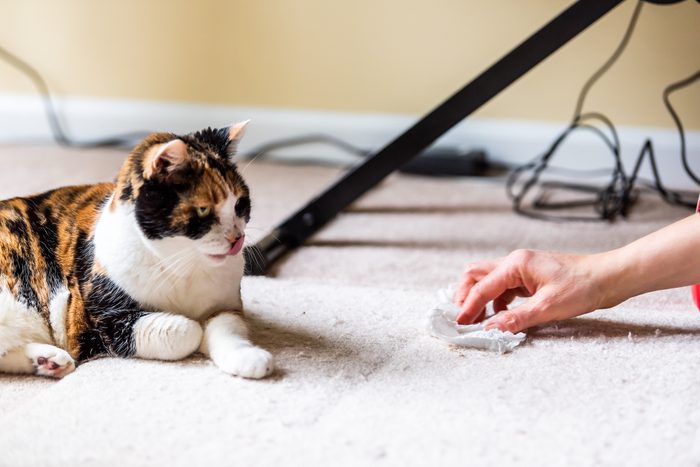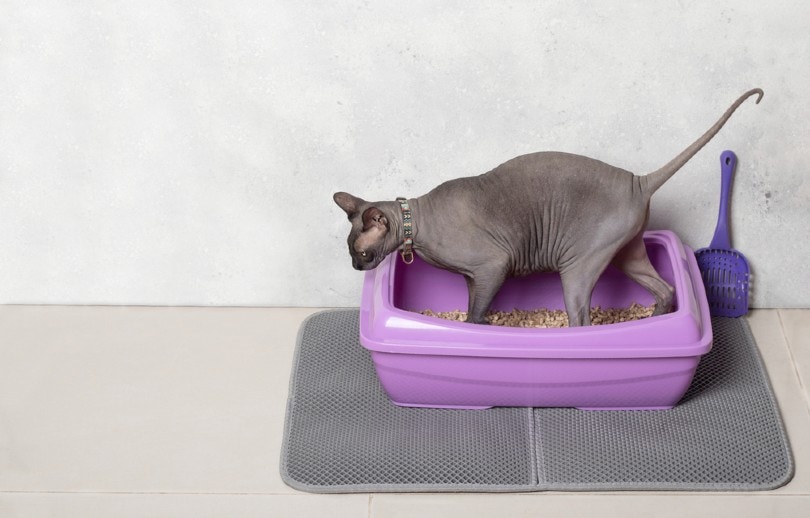Have you ever found yourself staring at a wet patch on your carpet, heart sinking as the realization dawns: your cat has peed outside the litter box again? It’s a frustrating experience for any cat owner, and it often leads to a sense of confusion and even guilt. Why is your feline friend behaving this way? Is it a sign of illness, or perhaps a silent cry for help? The answer isn’t always simple, but understanding the underlying reasons can lead to successful solutions.

Image: www.rd.com
Urinary issues in cats are a common concern. Whether it’s a sudden change in bathroom habits or a persistent pattern of accidents, it’s crucial to address the problem before it escalates. This article delves into the various reasons why cats might pee outside the litter box, exploring possible medical causes, behavioral factors, and practical steps you can take to address the issue. We’ll also discuss the importance of consulting your veterinarian to rule out any underlying health conditions, thus ensuring your beloved cat receives the care they need.
Understanding the Root Cause: A Holistic Approach
Unveiling the secret behind your cat’s sudden aversion to their litter box often starts with a process of elimination. Is it a medical issue, a behavioral quirk, or a combination of both? The key lies in understanding the possible causes and systematically addressing them.
1. Medical Factors: When Your Cat’s Body Sends Signals
A number of medical conditions can affect your cat’s ability to control their urination, leading to accidents outside the litter box:
- Urinary Tract Infections (UTIs): UTIs are common in cats, especially females, causing pain and discomfort during urination, potentially leading to accidents outside the litter box.
- Lower Urinary Tract Disease (FLUTD): FLUTD encompasses a range of conditions, including inflammation, crystals, and bladder stones, leading to pain, frequent urination, and even blood in the urine.
- Kidney Disease: Kidney disease can affect a cat’s ability to concentrate urine, resulting in increased urine volume and more frequent urination, making accidents more likely.
- Diabetes: Diabetes mellitus can cause a cat to drink more and urinate more frequently, sometimes leading to accidents.
- Hyperthyroidism: Hyperthyroidism can increase a cat’s metabolism and lead to increased urination.
If your cat is exhibiting any of these symptoms, it’s crucial to seek veterinary attention immediately. Early diagnosis and treatment can prevent complications and improve your cat’s overall health.
2. Behavioral Factors: A Deeper Look at Your Cat’s World
Just as medical conditions can contribute to indoor accidents, so too can behavioral factors play a crucial role. Understanding your cat’s emotional state, preferences, and environment can help you pinpoint the root of the issue:
- Litter Box Aversion: Cats are notoriously finicky about their litter boxes. A change in litter type, location, or cleanliness can prompt a cat to seek alternative “toilets.”
- Stress and Anxiety: Changes in your cat’s environment, such as a new pet, loud noises, or even a change in routine, can cause stress and anxiety, leading to accidents.
- Territoriality: Cats, by nature, view their territory with a sense of ownership. The presence of another animal or even the introduction of new furniture can trigger territorial conflict, prompting them to mark their territory with urine.
- Medical History: If your cat has experienced previous urinary accidents, they may become “trained” to go outside the litter box due to a learned behavior.

Image: www.hepper.com
3. Environmental Factors: Creating a Litter Box Paradise
The environment in which your cat lives can greatly influence their litter box habits. Here’s how you can optimize your cat’s litter box experience:
- Location, Location, Location: Choose a quiet, easily accessible spot for the litter box, away from busy areas and noise. Avoid placing it near their food and water bowls, as cats often prefer to relieve themselves in a separate location.
- Litter Box Size and Style: Ensure the litter box is large enough for your cat to comfortably turn around in. Consider offering multiple litter boxes, especially if you have multiple cats. Explore various litter box styles, such as covered boxes, to see what your cat prefers.
- Litter Type: Experiment with different litter types to find one your cat enjoys. Some cats prefer clay litter, while others prefer silica or wood-based alternatives. Remember, changes should be introduced slowly, allowing your cat to adjust gradually.
- Cleanliness Is Key: Scoop the litter box daily, and change the litter entirely at least once a week. Clean the box thoroughly with a pet-safe cleaner, as any lingering odor can deter your cat from using it.
Solving the Puzzle: A Step-by-Step Guide
Now that we’ve identified the possible culprits behind your cat’s bathroom mishaps, it’s time to strategize a plan of action. Here’s a step-by-step approach to finding a solution:
- Veterinary Visit: Rule out any underlying medical conditions by scheduling a vet appointment. Your veterinarian can perform a physical exam, run urine tests, and recommend further diagnostic tests if needed.
- Behavioral Evaluation: If medical issues are ruled out, consider consulting a certified veterinary behaviorist or animal behaviorist. They can help assess your cat’s behavior and offer personalized recommendations.
- Behavioral Modification: Implement positive reinforcement techniques. Reward your cat with treats and praise when they use the litter box. Avoid punishing accidents by rubbing their nose in it, as this can be counterproductive and lead to fear and stress.
- Environmental Enrichment: Create a stimulating environment for your cat by providing scratching posts, climbing structures, and toys. Encouraging playtime and mental stimulation can help alleviate boredom and reduce stress.
- Litter Box Placement: Experiment with different locations for the litter box, making sure it’s readily accessible and in a quiet, secluded spot.
- Litter Type Trial: Switch to different litter types, offering a selection in multiple boxes. Monitor your cat’s preferences and choose the one they seem most comfortable with.
- Cleanliness: Maintain a rigorous cleaning schedule for the litter box, ensuring it’s always fresh and inviting.
- Patience and Consistency: Change takes time. Be patient and consistent with your efforts. It may take time for your cat to adjust to new routines and environmental changes.
Remember, every cat is an individual with unique preferences and quirks. You may need to try different methods before finding the right solution for your cat. Don’t give up, and keep working with your veterinarian and/or behaviorist to address the issue effectively.
My Cat Keeps Peeing On The Floor
Living Harmoniously: A Journey of Understanding
Living with a cat often involves a journey of understanding and compromise. Accidents outside the litter box are a common issue, but with patience, careful observation, and a willingness to adjust your approach, you can often find solutions that benefit both you and your feline companion. The key is to view your cat’s behavior as a communication tool, listening to the messages they’re sending and responding in a way that fosters a healthy and harmonious relationship.
Remember, the information provided in this article is intended for informational purposes only and does not constitute medical advice. Always consult your veterinarian for a proper diagnosis and treatment plan for any health concerns your cat may have.






